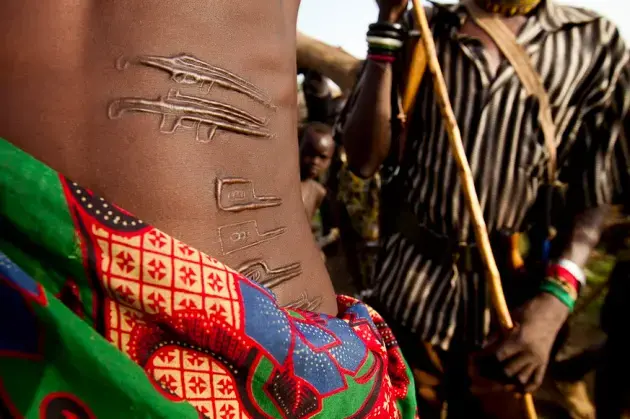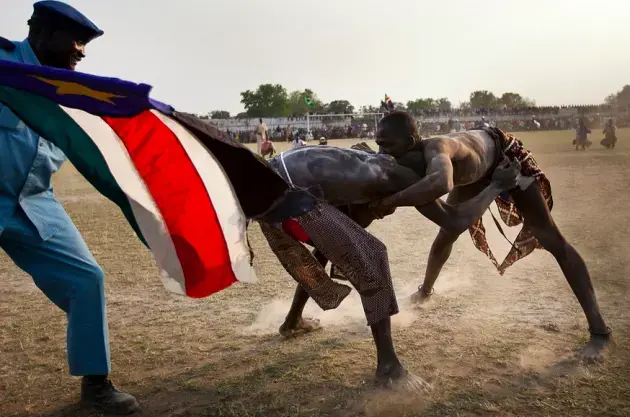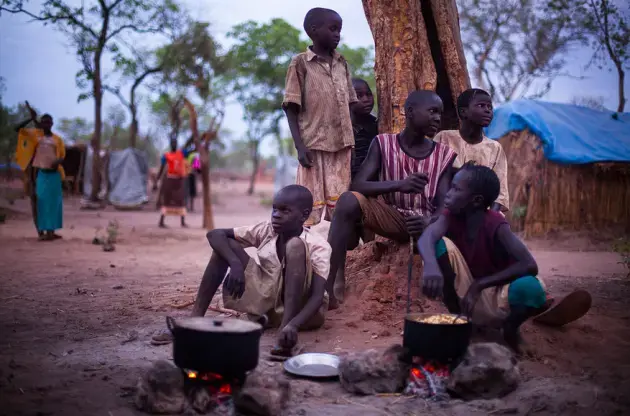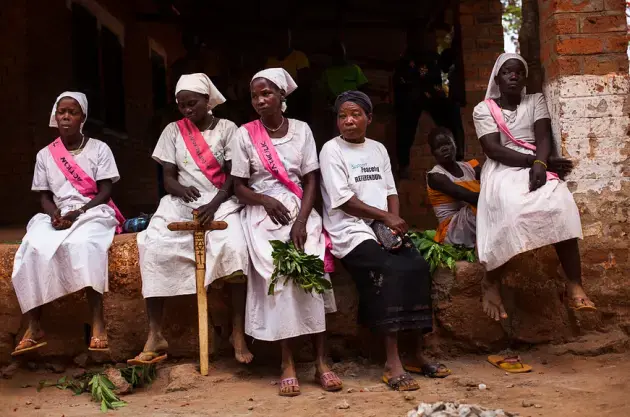Photographie.com: You have started reporting in Sudan three years ago, when tensions between the North and the South were rife, and an independent South Sudan was a distant dream. Why did you chose to focus on this country in the first place and what is this project meant to depict?
I had been following the conflict in Sudan for years. When the possibility of South Sudan's independence became a reality after the comprehensive peace agreement in 2005 was signed, I knew I wanted to report on the story. I am attracted to stories that defy standard media narratives. For example, I was eager to cover the revolutions in the Arab world because it was not just about terrorism, it was about something new and organic.
In South Sudan the narrative changed from yet another endless Africa civil war, to the birth of a country. What did this mean, who were the actors, how would this work, what would the people do, was it even possible? There were so many unknown questions, and endless stories and ways to approach the situation.
In my work, it is important to be able go back to the story, so I am careful to choose stories that have room for me to return to. This fall I went back to Libya and Egypt after the fall of their dictators to understand what happens next. (See piece in The New York Times Style magazine.) I am sure I will go back again.
Since my first visit to South Sudan in 2009 for a health NGO, I have been returning. Early on I did not know what shape my work in South Sudan would take, but I knew it would be a long term project. I was lucky to publish large stories in magazines like Newsweek and Geo, but this was still only part of the story and I knew that the work would eventually turn into a book size project.
This has always shaped what I choose to cover and pitch.
I believe in a complex country like South Sudan that is so different from my culture it is important to be very open to new ideas and approaches; it is only in the last year that I have felt comfortable making clear statements about South Sudan in my photography and stories. Before that my work was more exploratory.
The "Milk and Blood" book project is an attempt by myself and Time journalist Alan Boswell to make a rigorous critique of the state building process, the continuing violence against civilians, and the many interests that have coalesced around this new country. Alan's narrative is more analytical, while I hope my photographs, and films illuminate the paradoxes, the beauty, and the ugliness South Sudan's path out of war. (Or into a new war.)
We hope it is controversial, and we hope it gives decision makers a unique critical perspective, while offering a compelling portrait of the country to our readers.
Photographie.com: Less than a year since the birth of South Sudan, a new war is looming high over the two countries. What are the main reasons for these tensions, and what is the general atmosphere on the ground?
After three years in South Sudan, I believe that war may be the status quo, not peace. For this to change it will probably take a generation.
In many ways, the comprehensive peace agreement was a complete failure except as a way to get South Sudan's independence. None of the other issues that created the war were resolved. Oil proceeds, border demarcation, the disputed areas of Nuba mountains, Blue Nile, Abyei, and countless other details were pushed aside in order to gain the South's independence.
This was a big gamble by the West, and may or may not lead to a sustainable peace. What is clear from recent events is that there will be conflict in the border regions for many months, and probably years to come. Hardliners on both sides are holding their leaders hostage and forcing them into conflict. The international community has no clear plan on how to resolve this. For the moment the conflicts help each government gain support among it's population. But both sides are also broke, so it's unclear how long they can sustain this. In Juba, many people are optimistic, but outside of the capital, independence has brought little except for pride to most of South Sudan's citizens.
Photographie.com: Which areas of South Sudan are you planning to cover? Are foreign journalists well received there or is it a rather dangerous place to be?
Over the next several months I will be working throughout South Sudan for this book project, what I cover will depend on events on the ground and feedback from our readers. But one place I am sure to return to is Jonglei state, where tribal violence has killed thousands since the comprehensive peace agreement. The tribes in Jonglei have amazing cultures, a very traditional lifestyle, and they are gracious hosts. It is also a very very violent place. In some communities a man is not a man until he kills a person.
People in South Sudan like foreigners generally, but some are extremely paranoid as well. As a photographer, you are generally arrested or detained once a week.
Photographie.com: You are supporting the emergence of a "slower, deeper journalism." What are the characteristics of this new way of reporting and how are you going to apply it in South Sudan?
I have been following a slower journalism since I arrived in South Sudan. It's a term being used by a few other journalists. (Notably The Sochi project by Rob Hoarstra.) It means many different things to different journalists.
To me, a slower journalism means letting the story dictate the medium, the timetable, the budget, and the approach. And even as the pace of news seems to increase every day, I think that we are living in a perfect time for a slower journalism. No longer do we need to make weekly or daily deadlines, digital has freed us from that. A transmedia approach allows us to publish on story in multiple ways. A story can start as a tweet, move to a photo in a magazine, become a short film, for the web, and end up as a long form photo essay.
Today a premium is put on fast news and cheap news. To follow this path is to destroy the reason professional journalists exists, and also our mental and physical health. Media now asks us to do stories in a day that should take a week in order to cut costs. This is unacceptable and unethical to me, and a disservice to our readers.
As a photographer I am placed in very complicated ethical situations, photographing victims of a bombing, starving children, young men running off to war, people on their death bed. These intense situations deserve time. If I don't respect the situation and give it the time it deserves then two things happen. My photographs aren't very good and I find myself not respecting my subjects.
As a photographer and journalist this is difficult to live with. I think a lot of psychological trauma among photographers is the lack of time and space in the news cycle to process stories in a meaningful way.
This is unhealthy and dangerous for us, for our subject, and our readers. A slower journalism demands the time to make meaningful stories, the space to respect the subject and ourselves, and also the resources to give the story the medium it deserves.
And for all it's drawbacks, I believe digital opportunities offer us a way to do this that we are only beginning to explore. "Milk and Blood" is an attempt to foster a slower journalism while matching our extensive work in the field with the best in design and technology which we think the stories deserve.
Photographie.com: The main goal of your crowd funding project is to finance a digital book for the iPad. Why did you choose this format and which are the main characteristics of your future book? Do you think that this kind of format can engage more with people (can it be a key to solving the ills that are affecting news outlets and photojournalists alike)?
We are publishing an interactive eBook in order to bring together video, photo stories, radio, and a compelling text. It's not the perfect format, but it is the first time that we can bring together such diverse content in a powerful way that does justice to each medium.
The fact that we can update this book as we work on it, and apply feedback from our readers make this even more exciting. I think that eBooks will swell in popularity over the next five years and offer photographers an important vehicle for their work, and some profit. However, it is really only a stepping stone to entirely new ways of telling stories that will become available to us in the future. The digital revolution is just beginning for journalism, and new opportunities and ways of telling stories are born every day. We want to keep up on this technology and take advantage of it, but at the end of the day it's important to realize that the key to journalism is not technology. It's just going to places, and talking to people, even if those places are very far away.
Photographie.com: Why did you chose to crowd fund your project?
We are crowdfunding this project because we want other people to share in this process. We are also looking for committed readers who can give us feedback on the book as we make it. Crowd funding is only partly about raising money, our more important goal is creating community.
In order to support this project, please visit : www.emphas.is














